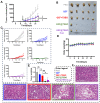Cocrystallization of Gefitinib Potentiate Single-Dose Oral Administration for Lung Tumor Eradication via Unbalancing the DNA Damage/Repair
- PMID: 38140054
- PMCID: PMC10747925
- DOI: 10.3390/pharmaceutics15122713
Cocrystallization of Gefitinib Potentiate Single-Dose Oral Administration for Lung Tumor Eradication via Unbalancing the DNA Damage/Repair
Abstract
Gefitinib (GEF) is a clinical medication for the treatment of lung cancer targeting the epidermal growth factor receptor (EGFR). However, its efficacy is remarkably limited by low solubility and dissolution rates. In this study, two cocrystals of GEF with co-formers were successfully synthesized using the recrystallization method characterized via Powder X-ray Diffraction, Fourier Transform Infrared Spectroscopy, and 2D Nuclear Overhauser Effect Spectroscopy. The solubility and dissolution rates of cocrystals were found to be two times higher than those of free GEF. In vitro cytotoxicity studies revealed that the cocrystals enhanced the inhibition of cell proliferation and apoptosis in A549 and H1299 cells compared to free GEF. In mouse models, GEF@TSBO demonstrated targeted, safe, and effective antitumor activity with only one-dose administration. Mechanistically, the GEF cocrystals were shown to increase the cellular levels of damaged DNA, while potentially downregulating PARP, thereby impairing the DNA repair machinery and leading to an imbalance between DNA damage and restoration. These findings suggest that the cocrystallization of GEF could serve as a promising adjunct to significantly enhance the physicochemical and biopharmaceutical performance for lung cancer treatment, providing a facial strategy to improve GEF anticancer efficiency with high bioavailability that can be orally administrated with only one dose.
Keywords: DNA damage and repair; co-formers; cocrystal; gefitinib; oral administration.
Conflict of interest statement
The authors declare no conflict of interest.
Figures








References
-
- Benowitz A.B., Scott-Stevens P.T., Harling J.D. Challenges and Opportunities for in Vivo PROTAC Delivery. Future Med. Chem. 2022;14:119–121. - PubMed
LinkOut - more resources
Full Text Sources
Research Materials
Miscellaneous

